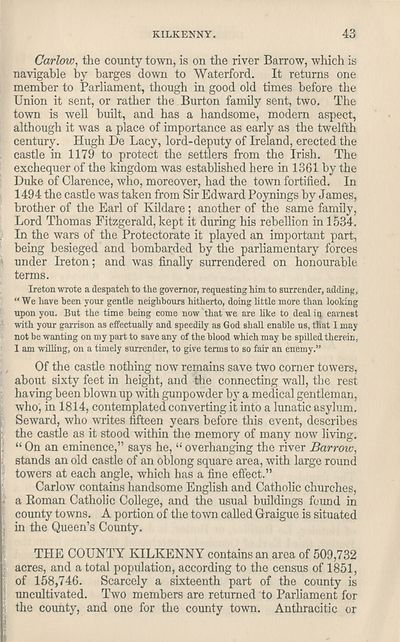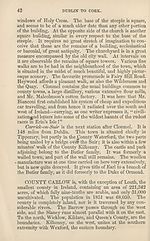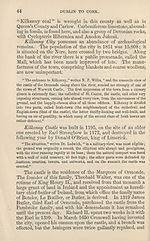Download files
Complete book:
Individual page:
Thumbnail gallery: Grid view | List view

KILKENNY.
43
Carlow, the county town, is on the river Barrow, which is
navigable by barges down to Waterford. It returns one
member to Parliament, though in good old times before the
Union it sent, or rather the Burton family sent, two. The
town is well built, and has a handsome, modem aspect,
although it was a place of importance as early as the twelfth
century. Hugh De Lacy, lord-deputy of Ireland, erected the
castle in 1179 to protect the settlers from the Irish. The
exchequer of the kingdom was established here in 1361 by the
Duke of Clarence, who, moreover, had the town fortified. In
1494 the castle was taken from Sir Edward Poynings by James,
brother of the Earl of Kildare; another of the same family,
Lord Thomas Fitzgerald, kept it during his rebellion in 1534.
In the wars of the Protectorate it played an important part,
being besieged and bombarded by the parliamentary forces
under Ireton; and was finally surrendered on honourable
terms.
Ireton wrote a despatch to the governor, requesting him to surrender, adding,
“We have been your gentle neighbours hitherto, doing little more than looking
upon you. But the time being come now that we are like to dealiq earnest
with your garrison as effectually and speedily as God shall enable us, that I may
not be wanting on my part to save any of the blood which may he spilled therein,
1 am willing, on a timely surrender, to give terms to so fair an enemy.”
Of the castle nothing now remains save two comer towers,
about sixty feet in height, and the connecting wall, the rest
having been blown up with gunpowder by a medical gentleman,
who; in 1814, contemplated converting it into a lunatic asylum.
Seward, who writes fifteen years before this event, describes
the castle as it stood within the memory of many now living.
“ On an eminence,” says he, “ overhanging the river Barrow,
stands an old castle of an oblong square area, with large round
towers at each angle, which has a fine effect.”
Carlow contains handsome English and Catholic churches,
a Roman Catholic College, and the usual buildings found in
county towns. A portion of the town called Graigue is situated
in the Queen’s County.
THE COUNTY KILKENNY contains an area of 509,732
acres, and a total population, according to the census of 1851,
of 158,746. Scarcely a sixteenth part of the county is
uncultivated. Two members are returned to Parliament for
the county, and one for the county town. Anthracitic or
43
Carlow, the county town, is on the river Barrow, which is
navigable by barges down to Waterford. It returns one
member to Parliament, though in good old times before the
Union it sent, or rather the Burton family sent, two. The
town is well built, and has a handsome, modem aspect,
although it was a place of importance as early as the twelfth
century. Hugh De Lacy, lord-deputy of Ireland, erected the
castle in 1179 to protect the settlers from the Irish. The
exchequer of the kingdom was established here in 1361 by the
Duke of Clarence, who, moreover, had the town fortified. In
1494 the castle was taken from Sir Edward Poynings by James,
brother of the Earl of Kildare; another of the same family,
Lord Thomas Fitzgerald, kept it during his rebellion in 1534.
In the wars of the Protectorate it played an important part,
being besieged and bombarded by the parliamentary forces
under Ireton; and was finally surrendered on honourable
terms.
Ireton wrote a despatch to the governor, requesting him to surrender, adding,
“We have been your gentle neighbours hitherto, doing little more than looking
upon you. But the time being come now that we are like to dealiq earnest
with your garrison as effectually and speedily as God shall enable us, that I may
not be wanting on my part to save any of the blood which may he spilled therein,
1 am willing, on a timely surrender, to give terms to so fair an enemy.”
Of the castle nothing now remains save two comer towers,
about sixty feet in height, and the connecting wall, the rest
having been blown up with gunpowder by a medical gentleman,
who; in 1814, contemplated converting it into a lunatic asylum.
Seward, who writes fifteen years before this event, describes
the castle as it stood within the memory of many now living.
“ On an eminence,” says he, “ overhanging the river Barrow,
stands an old castle of an oblong square area, with large round
towers at each angle, which has a fine effect.”
Carlow contains handsome English and Catholic churches,
a Roman Catholic College, and the usual buildings found in
county towns. A portion of the town called Graigue is situated
in the Queen’s County.
THE COUNTY KILKENNY contains an area of 509,732
acres, and a total population, according to the census of 1851,
of 158,746. Scarcely a sixteenth part of the county is
uncultivated. Two members are returned to Parliament for
the county, and one for the county town. Anthracitic or
Set display mode to:
![]() Universal Viewer |
Universal Viewer | ![]() Mirador |
Large image | Transcription
Mirador |
Large image | Transcription
| Antiquarian books of Scotland > Ireland/Irish > Black's guide to Killarney and the south of Ireland > (51) |
|---|
| Permanent URL | https://digital.nls.uk/118861280 |
|---|
| Description | Thousands of printed books from the Antiquarian Books of Scotland collection which dates from 1641 to the 1980s. The collection consists of 14,800 books which were published in Scotland or have a Scottish connection, e.g. through the author, printer or owner. Subjects covered include sport, education, diseases, adventure, occupations, Jacobites, politics and religion. Among the 29 languages represented are English, Gaelic, Italian, French, Russian and Swedish. |
|---|

